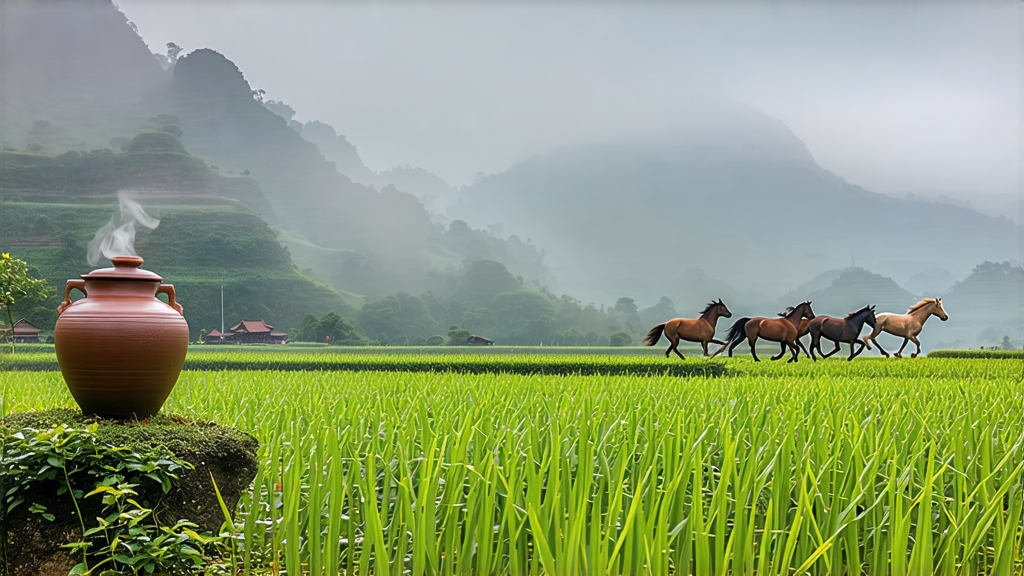
Tucked away in the humid, karst-pocked mountains of southern China’s Guangxi Zhuang Autonomous Region, Liu Bao cha—literally “Six Forts tea”—has spent four centuries quietly fermenting while its more famous cousin Pu-erh captured the global spotlight. Yet for those willing to listen, Liu Bao speaks in bass tones of camphor, betel nut and sweet soil, telling a story of Ming-dynasty soldiers, river coolies, maritime voyages and, more recently, of a new generation of tea lovers who crave depth without decadence.
1. Origins along the Tea-Horse Road’s wetter cousin
Unlike the celebrated caravan trail that ferried Yunnan Pu-erh to Tibet, Liu Bao travelled by water. From the port of Wuzhou on the Xi Jiang (West River) system, compressed baskets of dark leaves floated down to Guangzhou, then on to Hong Kong and Southeast Asia where Hokkien and Cantonese labourers drank it to cut through greasy dockside food and the cloying tropics. Dutch and British records from 1702 list “Lieu Pouw” among the “black teas of China,” predating the term “Pu-erh” in European logs by decades. The name itself memorialises the six historical fortresses—Liu Bao—that protected the mountain passes of Cangwu County, the heart of production still today.
2. From green to dark in one deliberate leap
Although now classified as a hei cha (dark tea), Liu Bao begins life as a pluck of local large-leaf cultivars—Yun Kang, Fu Yun and the heirloom Ling Yun—picked in late April when rains fatten the buds to a leathery resilience. The transformation is catalysed not by years of raw-puer-style aging but by a single, intense “pile-fermentation” (wo dui) that lasts 30–45 days, shorter than the 60-day Pu-erh norm but conducted in far more humid conditions.
The craft unfolds in seven tightly choreographed steps:
- Kill-green over wood-fired woks at 280 °C for three minutes—just enough to halt oxidation enzymes while preserving leaf integrity.
- Rolling while still hot, rupturing cells to release tacky juices that will later feed microbes.
- Piling: leaves are heaped 70 cm deep on bamboo mats in an unventilated room where ambient moisture hovers at 85 %. Thermophilic fungi such as Aspergillus niger and yeasts like Cyberlindnera multiply, driving the pile’s core to 55 °C. Every five days the heap is turned, sprayed with mountain spring water, and covered with wet jute—an echo of the rice-straw blankets once used.
- Re-firing to 80 °C for twenty minutes stabilises the colour and fixes the “betel-nut” note that connoisseurs prize.
- Steaming and basket pressing: semi-fermented leaf is steamed for 30 seconds, then tamped into 40 kg bamboo baskets lined with untreated banana leaf. The bamboo imparts a subtle green sweetness; the banana leaf prevents mould while allowing micro-oxygenation.
- Aging in humid caves or underground warehouses where temperatures stay 22–28 °C year-round. Traditionalists insist on at least three “summers” before release, arguing that Guangxi’s sweltering monsoon cycles are what knit the layers of flavour.
- Final sorting and charcoal bake to reduce moisture to 8 %, ensuring stability for export.
3. The flavour map: from camphor to candy
Young Liu Bao (1–3 years) pours a clear russet liquor with a nose of raw cacao, wet bark and a hint of smoked longan. Between 5–10 years the microbial party intensifies: lactic-acid bacteria soften astringency, yielding a thick, soy-sauce amber broth that coats the tongue like sherry. After fifteen years noble rot aromatics emerge—camphor, ginseng and the signature “betel-nut” finish reminiscent of the areca chew beloved across Southeast Asia. The cup remains bright, never plunging into the earthy heaviness of some Pu-erhs; it is darkness with lift, a bass-baritone capable of high notes.
4. Compression styles: baskets, bricks and the elusive “turtle shell”
Most Liu B